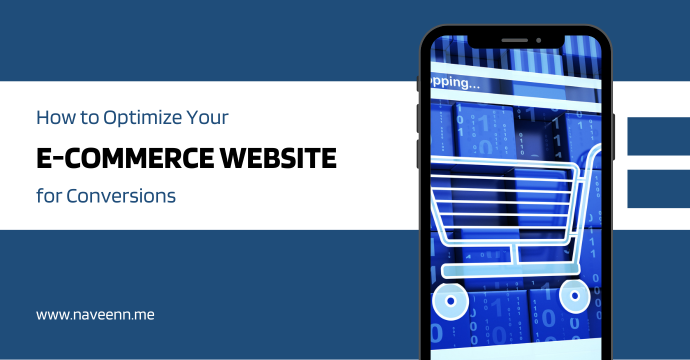In the competitive world of e-commerce, having a visually appealing website is just the first step. The true challenge is turning visitors into customers.
Optimizing your e-commerce website for conversions involves a blend of user experience (UX) enhancements, strategic content placement, and leveraging data-driven insights. In this blog, we will explore effective strategies to boost your E-commerce conversions.
What is E-commerce Optimization?
E-commerce optimization involves refining and enhancing various elements of an online store to improve user experience, boost conversion rates, and increase overall performance, ultimately maximizing profits.
In essence, e-commerce optimization means fine-tuning every aspect of your store to create the best possible experience for your potential customers. When customers are satisfied, they are more likely to make a purchase, which increases your sales and profits.
There are numerous e-commerce optimization strategies to consider, including focusing on website design and user experience, optimizing product listing pages, and streamlining checkout processes.
Read More: Trends and Innovations in Web Development
Essential Tips for E-commerce Optimization
E-commerce optimization involves improving various aspects of an online store to increase traffic, enhance user experience, and boost sales. It encompasses several strategies and tactics, including:
Improve Website Speed
Website speed is essential for user satisfaction and search engine rankings. A slow-loading website can frustrate visitors and will increase the bounce rate. Here’s how you can optimize your website speed:
- Compress images: Use tools like TinyPNG or JPEG Optimizer to reduce image file sizes without compromising quality.
- Leverage browser caching: Store static files in the user’s browser cache to reduce load times on subsequent visits.
- Minimize HTTP requests: Cut down on the number of elements on your page to minimize HTTP requests.
Optimize for Mobile Users
With a significant portion of online shopping done on mobile devices, ensuring your website is mobile-friendly is paramount. Google’s mobile-first indexing means your site’s mobile version is used for ranking and indexing. Here are some tips:
- Responsive design: Implement responsive web design to make sure your site adjusts seamlessly to various screen sizes.
- Simplify navigation: Make sure menus are easy to navigate on smaller screens.
- Optimize images and content: Ensure images and other media load quickly on mobile devices.
Enhance User Experience (UX) for E-commerce Website
A seamless and intuitive user experience can significantly improve your conversion rates. Focus on the following areas:
- Clear call-to-action (CTA): Use compelling and visible CTAs to guide users through the buying process.
- Simplified checkout process: Reduce the number of steps required to complete a purchase. Offer guest checkout options and minimize form fields.
- Easy navigation: Use a clear, logical menu structure and include a search bar to help users find products quickly.
Leverage High-Quality Visuals and Descriptions
Product images and descriptions play a vital role in convincing visitors to make a purchase. Here’s how to optimize them:
- High-resolution images: Use multiple high-quality images from different angles. Include zoom-in features.
- Detailed product descriptions: Write informative and engaging descriptions that highlight key features and benefits. Use bullet points for easy readability.
- Customer reviews and ratings: Showcase customer reviews and ratings to build trust and offer social proof.
Implement A/B Testing
A/B testing involves comparing two versions of a webpage to determine which one performs more effectively. This can help you understand what changes lead to higher conversions. Focus on testing:
- Headlines and CTAs: Experiment with different headlines and call-to-action buttons.
- Page layouts: Test different layouts to see which one improves user engagement.
- Product pages: Compare different product page designs, descriptions, and images.
Utilize Social Proof and Trust Signals
Establishing trust is key to converting visitors into customers. Integrate social proof and trust signals throughout your site to achieve this:
- Customer testimonials: Showcase positive customer experiences and testimonials.
- Trust badges: Display security badges and certifications to reassure visitors.
- Social media integration: Include links to your social media profiles and display social media testimonials.
Search Engine Optimization(SEO) for E-commerce
SEO is vital for attracting organic traffic to your e-commerce site. Here are some key practices:
- Keyword research: Find relevant keywords and include them in your product titles, descriptions, and meta tags.
- Quality content: Create valuable content, such as blog posts, buying guides, and product comparisons, to attract and engage visitors.
- Technical SEO: Ensure your site has a clean URL structure, uses HTTPS, and has a sitemap.
Utilize Email Marketing
Email marketing is a powerful tool for nurturing leads and encouraging repeat purchases. Optimize your email campaigns by:
- Segmentation: Segment your email list based on customer behavior and preferences to deliver personalized content.
- Abandoned cart emails: Send reminders to customers who have left items in their cart without completing the purchase.
- Promotional offers: Share exclusive offers, discounts, and product recommendations to incentivize purchases.
Analyze and Optimize
Regularly analyze your website’s performance to identify areas for improvement. Use tools like Google Analytics to monitor:
- Traffic sources: Understand where your visitors are coming from and which channels are most effective.
- Conversion rates: Track the conversion rates of different pages and identify bottlenecks.
- User behavior: Analyze user behavior to understand how visitors interact with your site and where they drop off.
Conclusion
Optimizing your e-commerce website for conversions is an ongoing process that involves continuous testing, analysis, and improvement.
By focusing on website speed, mobile optimization, user experience, high-quality visuals, A/B testing, social proof, SEO, email marketing, and regular analysis, you can significantly enhance your conversion rates.
Implement these strategies to create a seamless and engaging shopping experience that turns visitors into loyal customers.
